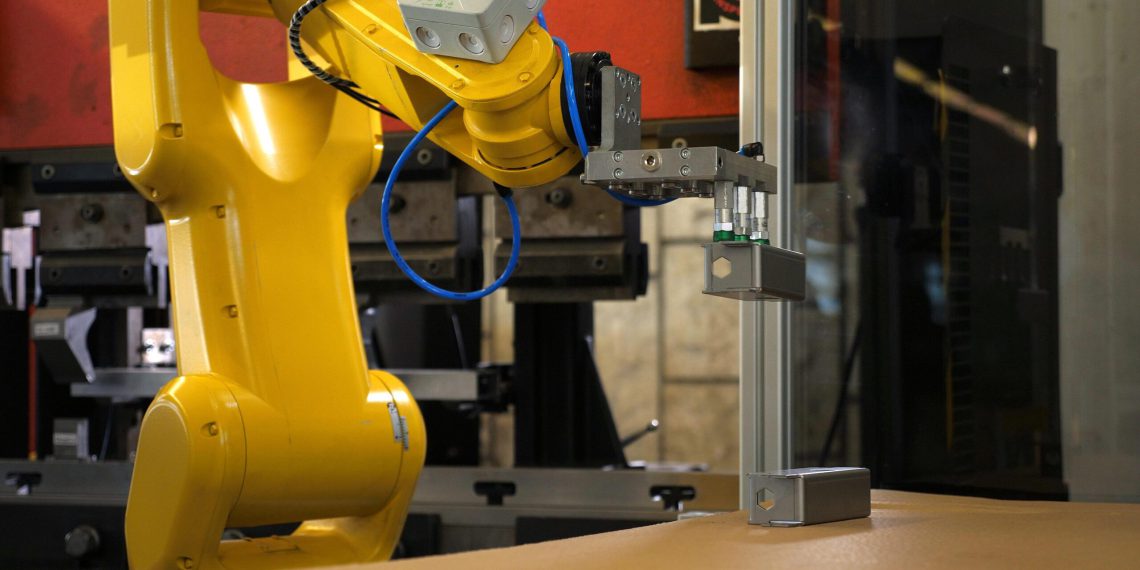For sheet metal bending, a Lithuanian-led partnership has developed the world’s first standardized robotic cell — an innovation that adds flexibility to manufacturing and could be the key to overcoming the shortage of skilled workers in the sheet metal industry in Germany and across Europe.
Bent sheet metal parts are needed everywhere — but current manufacturing processes use expensive single-purpose machines that cannot be adapted to changing requirements. The advantage of the RoboBend is that it can be programmed to produce a wide range of products. The robot can be installed in existing production lines and is compatible with all existing press brakes. The bending time depends on the difficulty of the part to be produced and ranges from one minute for simple parts to 2–3 minutes for more demanding parts.
History of the innovation
“The idea started in 2017, when one of Factobotics’ customers asked for a customized robotic solution for sheet metal bending. We soon realized that many other companies had a similar problem. The answer was a standardized robot — so we founded RoboBend. So the robotic solution came out of the collaboration with Factobotics, but Robobend is now an independent company.”
- Thomas Ronlev, CEO and co-founder
Since then, the robot manufacturer has received orders from the automotive, construction, food and other industries. Initially focused on the Danish market, RoboBend has also attracted interest in Lithuania, where Factobotics is based. Now RoboBend is ready to expand its operations and focus on new export markets. Starting in 2022, the company is targeting customers throughout Northern Europe — especially in Germany.
Great opportunity
With 150,000 to 200,000 press brakes currently in operation, Germany is a huge market for RoboBend, which has already received inquiries from German companies and distributors. “Germany is crucial for us because it has a big lead in manufacturing — and a big interest in keeping it,” Ronlev explains. “German companies are relying on robotization to maintain their leadership position because it’s getting harder to find skilled workers.”
Indeed, skilled labor is a major problem across Europe. The European Commission’s Skills Panorama portal predicts 2.7 million unfilled metal engineering jobs in the EU by 2030. “Skilled workers are critical to the success of manufacturing — but the coming generations are choosing other professions. That’s why robots are the solution,” says Ronlev.
Justinas Katkus, co-founder and head of product design at Factobotics, points out that automation is not a threat to jobs, but increases the value of skilled labor, “Robots help preserve jobs, not take them away. Thanks to robots, factories can maintain the same or higher capacity. And that means the money stays in Europe — in the form of jobs, wages, supply chains and investment. Globally, the trend is toward less repetitive work,” he adds. “Everyone wants to move people up the value chain.”
With the COVID-19 pandemic disrupting global supply chains, manufacturers are also realizing they can no longer rely on suppliers in far-flung locations like China. As robotic solutions become more powerful, cheaper and easier to implement, companies are reversing the process of offshoring to move production closer to home — helping to make their supply chains more resilient.
The future of robotics
Robotics has advanced rapidly in recent years. Next-generation robots like RoboBend are smarter and easier to program and operate, with intuitive, user-friendly interfaces. They can be easily integrated into existing production processes without having to redesign the entire production line.
In addition, robotization no longer requires the same high initial investment — the increasingly popular Robots as a Service (RaaS) business model allows companies to lease rather than buy robots, making robots an attractive option even for smaller companies with low volumes.

















